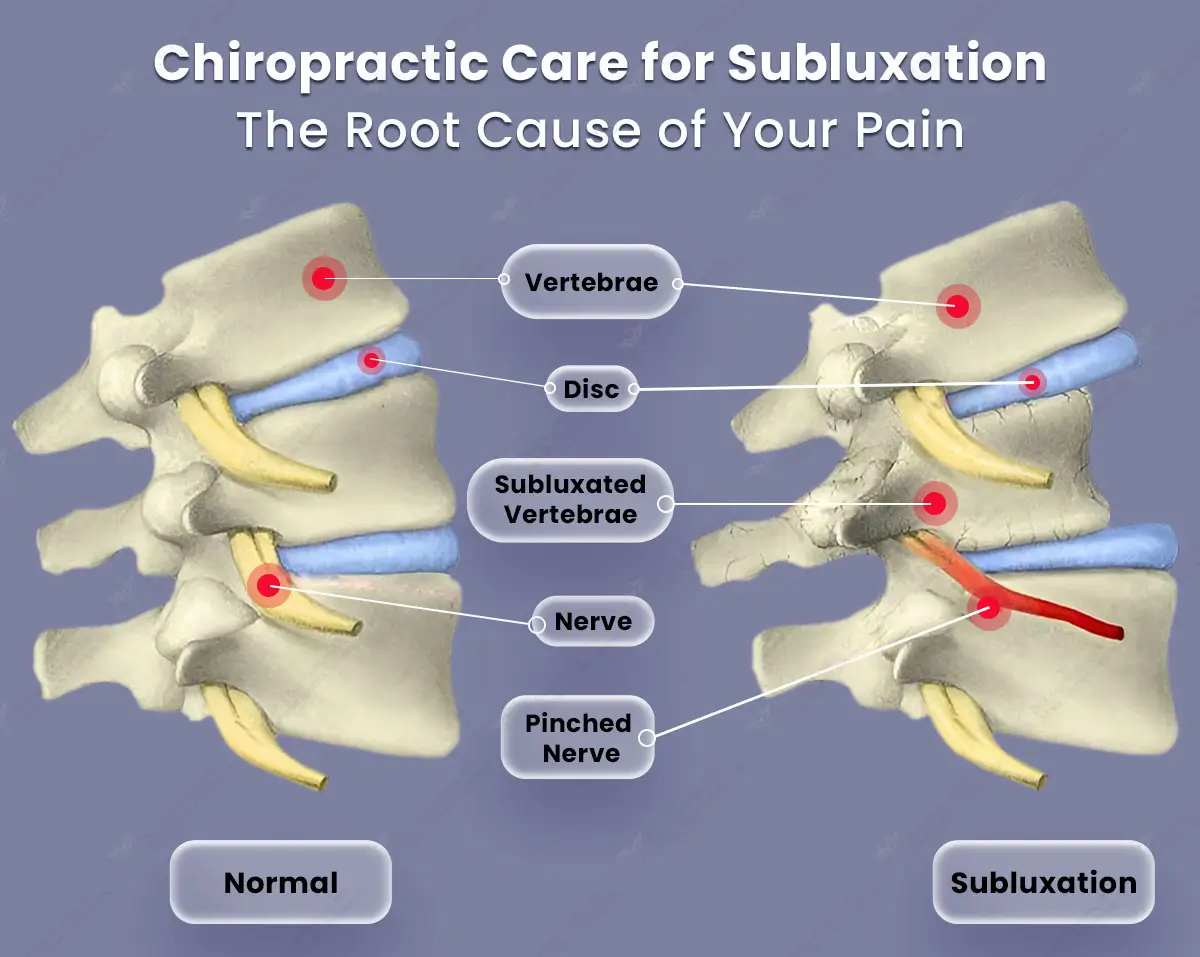
Subluxation is common in chiropractic care, although many patients must know its definition and relevance. Simply put, a subluxation is a partial misalignment of the joints, particularly in the spine. Understanding chiropractic care for subluxation is crucial for anyone looking to improve their overall health.
As a chiropractor with over 20 years of expertise, I’ve seen firsthand how subluxations may substantially influence a person’s health and quality of life. This complete guide will explain what a subluxation is, the different types of it, its symptoms, what causes them, and how chiropractors fix them.
What is a Subluxation?
A subluxation occurs when there’s a partial misalignment or slight loss of contact in the joints of your body. Although this may occur in any joint, it’s most commonly associated with the spine. As a chiropractor, I frequently illustrate subluxations to my patients with a simple analogy:
Think of your spine as a complicated highway system. The nerves that extend from your head to your body are like the cars that carry important messages. A subluxation slows down or blocks the flow of information, like a minor traffic jam on this highway.
There are two main types of subluxations:
- Vertebral Subluxations: Spinal subluxations occur in the spine and are the primary focus of chiropractic care. Misalignments of the vertebrae can strain the nerves that leave the cervical spine.
- Peripheral Joint Subluxations: These can occur in other body joints, such as the shoulder, knee, or wrist. While less common, they can still cause significant discomfort and functional issues.
Subluxations can influence the body in various ways, mainly by influencing the nervous system’s functions. If a vertebra is out of place, it can irritate or press on nearby nerves, which can cause several symptoms and health problems. Some potential symptoms of subluxations include:
- Pain and discomfort
- Reduced range of motion
- Muscle weakness or imbalance
- Decreased immune system response
- Headaches or migraines
- Fatigue and reduced energy levels
It’s vital to understand that subluxations rarely cause instant or visible signs. Sometimes, the body can adapt to these misalignments, masking the underlying issue until more severe problems develop.

Causes of Subluxations
- Trauma: I’ve treated many patients whose subluxations resulted from accidents or falls. Even minor impacts can misalign the spine.
- Repetitive Strain Injuries: I frequently see this in patients who work at a desk or do physical tasks repeatedly. The constant stress on certain joints can gradually lead to misalignment.
- Poor Posture: This is becoming increasingly common in our modern, sedentary lifestyle. I often educate patients on how their daily posture habits can significantly impact their spinal health.
- Environmental Toxins: I’ve observed that exposure to pollutants and chemicals can affect the body’s ability to maintain proper alignment.
- Nutritional Deficiencies: As a chiropractor, I’ve seen that a poor diet can weaken the muscles and ligaments that support the spine, making it more likely that the spine will become subluxated.
- Stress: The tension in our bodies caused by stress can directly lead to subluxations. I constantly include stress management measures in my clients’ overall therapy plans.
What is the Difference Between a Dislocation and a Subluxation?
Dislocation
- A dislocation occurs when two bones in a joint get entirely separated.
- It’s usually the result of significant trauma or injury.
- Dislocations are often extremely painful and immediately noticeable.
- Usually, they need medical help right away and may need manual reduction to realign the joint.
Subluxation
- A subluxation is a minor or mild misalignment in the joints.
- It may develop gradually over time or as an outcome of minor trauma or repeated stress.
- Subluxations may not always cause immediate pain or apparent symptoms.
- Adjustments from a chiropractor can often fix them, and they don’t usually need emergency medical help.
- Imaging checks (such as X-rays) are frequently used to confirm a diagnosis and rule out breaks in dislocations.
- Dislocations can be treated with immobility, physical therapy, or surgery in severe instances.
- Chiropractic adjustments and physical therapy are usually adequate for treating subluxations.
- While dislocations are acute conditions that require immediate care, subluxations can be chronic issues that benefit from ongoing chiropractic maintenance.
How Chiropractors Treat Subluxations
As a chiropractor, my approach to treating subluxations is rooted in the philosophy of the body’s natural ability to heal itself when the nervous system is functioning optimally. By addressing subluxations, I aim to remove nerve interference and allow the body to restore its natural balance.
These are some of the most essential chiropractic protocols for subluxation I use in my clinic.
1. Manual Adjustments
Spinal manipulations are the cornerstone of chiropractic care. I manually correct vertebral Subluxation using precise, controlled force to restore proper alignment and movement. These modifications can offer instant relief and enhance overall function.
2. Physical Rehabilitation
I typically indicate targeted exercises that target the muscles supporting those with injured joints. This helps maintain proper alignment and prevent future subluxations.
3. Lifestyle and Ergonomic Advice
Poor posture, poor carrying techniques, and repeated motions can cause or accelerate different subluxations. I guide modifying daily activities to reduce stress on the spine and joints.
4. Nutritional Counseling
Proper eating can help reduce irritation while enhancing joint health. I often suggest nutritional tips with my patients as part of a complete treatment strategy.
5. Soft Tissue Therapies
Often, subluxations are accompanied by muscle tension or imbalances. Myofascial release, trigger point treatment, and therapeutic massage are some of the techniques that can help loosen up tight muscles and make joints work better overall.
Realize that there is no generic strategy for addressing subluxations. Each patient’s treatment regimen is tailored to their condition, overall health, and lifestyle factors. This tailored approach guarantees the most successful and productive path to recovery.
How is Subluxation Corrected?
Correcting a subluxation is a process that requires a systematic approach. Here’s a step-by-step breakdown of how I typically address subluxations in my practice:
1. Initial Assessment and Diagnosis
- Conduct a thorough patient history to understand symptoms and potential causes
- Examine the body that includes a range of motion tests and palpation
- Order imaging inquiries like X-rays or an MRI to better view the dislocation.
2. Treatment Plan Development
- Based on the assessment, create a customized treatment plan
- Determine the frequency and type of adjustments needed
- Identify complementary therapies that may be beneficial
3. Implementation of Chiropractic Adjustments
- Perform manual or instrument-assisted adjustments to correct the Subluxation
- Use gentle, controlled force to guide the joint back into proper alignment
- Patients often hear a ‘popping’ sound during the adjustment process, just a gas discharge from the joint.
4. Follow-up Care and Monitoring
- Schedule regular follow-up discussions to assess progress.
- Make changes to the therapy plan as necessary.
- Gradually decrease treatment frequency as the patient’s condition improves.
It’s important to note that patient participation plays a crucial role in the success of subluxation correction. I always emphasize the importance of:
- Following through with prescribed home exercises
- Maintaining proper posture and ergonomics
- Adopting lifestyle changes to support spinal health
- Attending all scheduled appointments for consistent care
When you fix a misalignment, it’s not just about getting relief immediately. It is also about restoring the body’s regular operation and avoiding disorders. An integrated strategy, including in-office therapies and at-home care, is essential.
Is Subluxation Causing Your Discomfort?
Get expert chiropractic care to address your pain at its source.
Schedule a ConsultationThe Final Words
Understanding subluxations is essential to preserving optimal spinal health and overall health. These subtle misalignments can significantly impact your body’s function, affecting your spine and entire nervous system. If you know how to spot the signs of misalignment and get chiropractic care immediately, you can prevent these problems before they worsen.
Maintaining spinal health is a constant endeavor that involves expert care and daily lifestyle changes.
If you’re in pain or want to enhance your health, consider chiropractic treatment. Contact my practice today to schedule an evaluation, and I will craft a plan to free you from constant pain.
REFERENCE
- Sciencedirect.com. (n.d.). Subluxation. [online] Available at: https://www.sciencedirect.com/topics/pharmacology-toxicology-and-pharmaceutical-science/subluxation
- Oak Park Family Chiropractic. (n.d.). Understanding subluxation: Causes, symptoms, treatment. Retrieved July 24, 2024, from https://oakparkfamilychiropractic.com.au/subluxation/
- Penn Medicine. (n.d.). Joint dislocation – symptoms and causes. Retrieved July 24, 2024, from https://www.pennmedicine.org/for-patients-and-visitors/patient-information/conditions-treated-a-to-z/dislocation

Meet Dr. Craig Eymann, a dedicated chiropractor and yoga enthusiast with over two decades of expertise in spinal health, sports chiropractic, and personalized care, prioritizing misalignment correction for swift injury resolution.




Leave A Comment